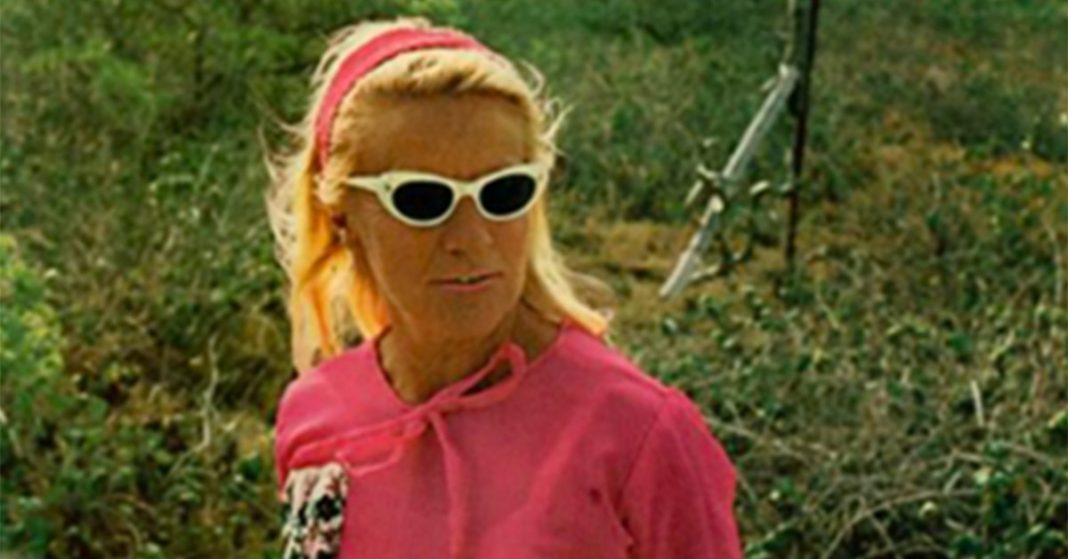By Jann Barry
In 1970, US freelance photographer Malcolm Kirk sailed to remote Wreck Island on the Great Barrier Reef. His purpose: to photograph former Lord Howe Island resident, Julie Booth. Malcolm was working in the South Pacific at the time and recalled “…when the Smithsonian assigned me to photograph her I was warned that she would drive me off the island with a shotgun if I tried to come ashore alone, so I brought my (first) wife with me.”
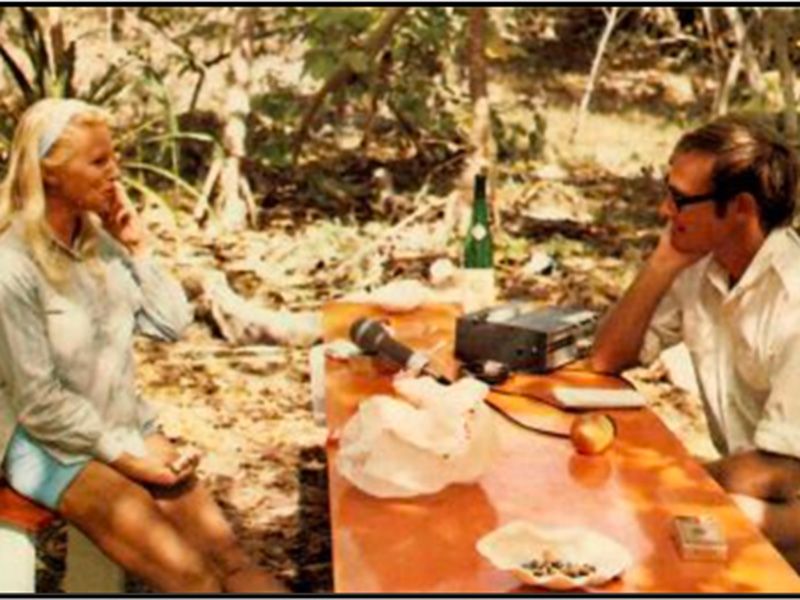
Photographer Malcolm Kirk interviewing
Julie Booth on Wreck Island, 1970
Photograph copyright of Malcolm Kirk
(used with permission)
By then, Julie was 46 years old and had been living her own version of the popular TV series “Alone” on a series of small coral islands in the Great Barrier Reef for five years. She had endured cyclones, isolation and insect infestations, and near starvation when storms cut off her food supply.
In 1968, Bundaberg brothers Ken and Ralph Whalley, found Julie “close to death from starvation” when their fishing boat was forced onto Fairfax Island in a storm. Julie had been cut off from supplies from the mainland, her hands raw and bleeding after digging for shellfish in the sand. At the time her only way to contact the outside world was a flare system relayed through the Lady Elliott lighthouse. The storms had meant Julie had been unable to signal for help (1).
Throughout these challenges Julie remained a committed, self-taught citizen scientist for organisations like the Australian Museum, National Geographic, the University of Florida and the Smithsonian Institute. On the coral cays of Wreck, Fairfax, One Tree and Heron Islands she studied turtles, bird life, fish, marine mammals and coral. Her research contributed to our understanding of these fragile environments, of which she was fiercely protective.
Julie on Wreck Island, 1970
Photograph copyright of Malcolm Kirk
(used with permission)
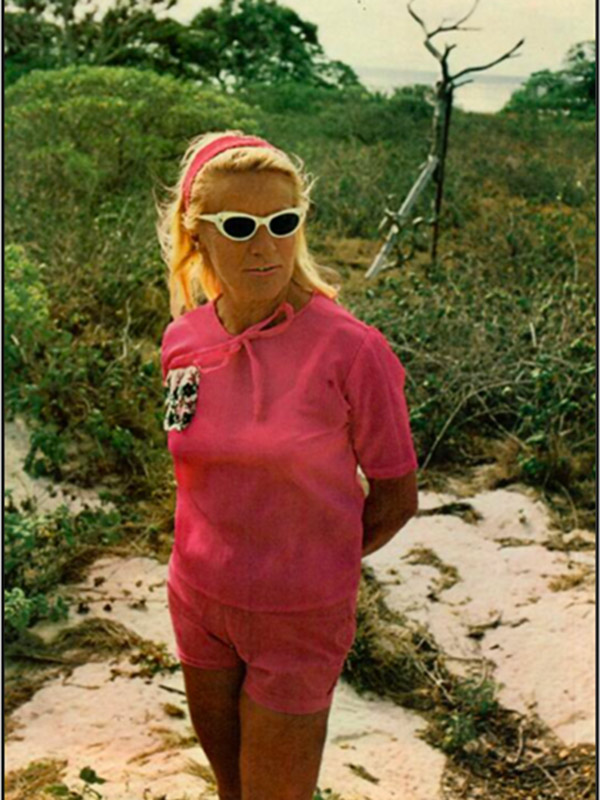
Julie would go on to spend a further twelve years on Fairfax and Wreck Islands, the sole inhabitant of these tiny cays, with periodic visits from son Carl and semi-regular supply boats. She had a long association with the Smithsonian Institute, sending them samples for identification and the results of her detailed studies. Julie went on to have peer reviewed articles published in natural science journals about her research findings. She eventually returned to the mainland in the early 1980’s. In her later years Julie lived in Rockhampton with Carl before passing away in 2017, aged 93.
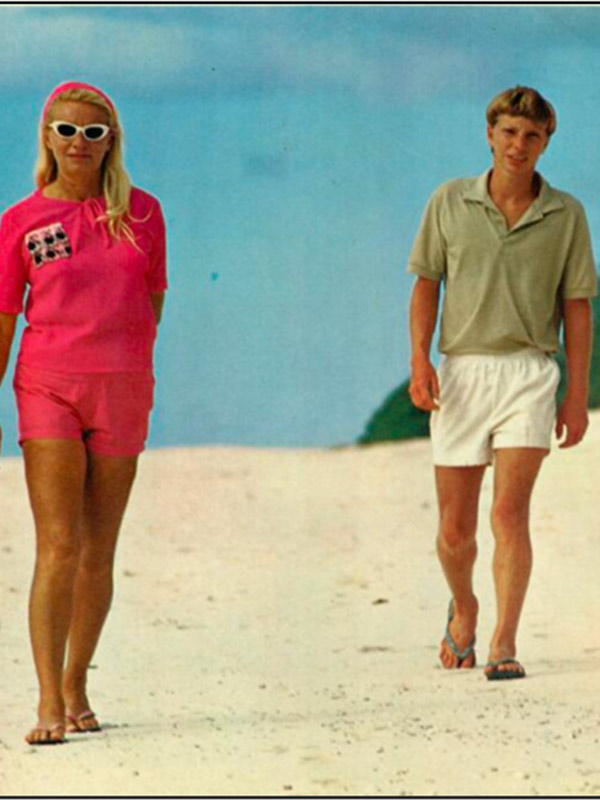
At vero eos et accusamus et iusto odio dignissimos ducimus qui blanditiis praesentium voluptatum deleniti atque corrupti quos dolores et quas molestias excepturi sint occaecati cupiditate non provident.
Julie’s passion for the flora and fauna of tropical islands can be traced back to her time on Lord Howe Island, where letters addressed simply to “The Mermaid” would find her successfully. And despite years of solitude, Malcolm’s photos (for the Smithsonian Magazine’s 1971 article “The Lady Crusoe of Australia’s Tropical Islands”), show Julie never lost her taste for glamour!
Julie was born June Vincent in 1924, the oldest child of Sydney and Gladys (nee Eschler). Her career as an amateur naturalist began at an early age. Living in Maroubra she brought home local sea creatures, then at the age of 10 started taking them to the Australian Museum to be identified.
As a young woman Julie was a natural exhibitionist. In her 20’s she was part of a tourist spectacle at Catalina Park in Katoomba. There, dressed as a mermaid, she would dive off the wings of a Catalina aircraft moored in the artificial lake, then swim around the plane accompanied by classical music.
Catalina Park, Katoomba c. 1950
Image courtesy Blue Mountains Library
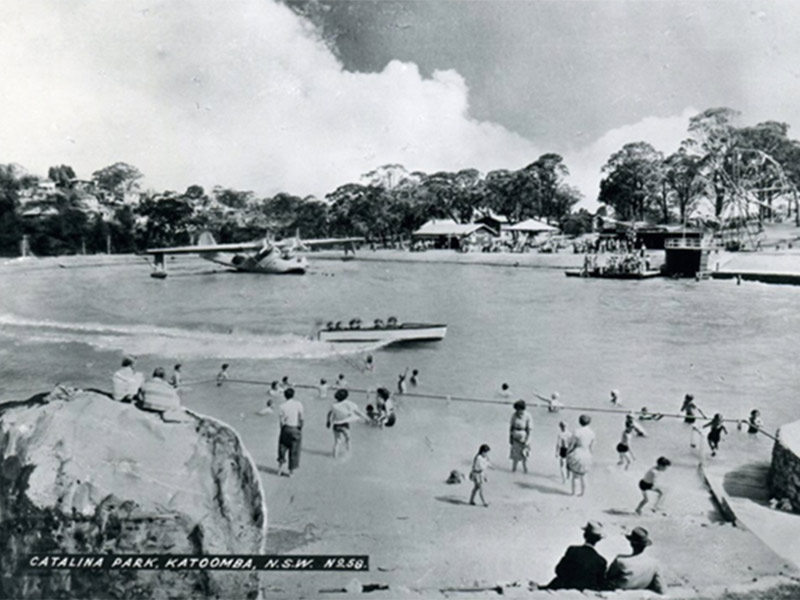
Julie married GP Howard Booth in 1949, faithfully working in his mining town and suburban practices as assistant and nurse. When the marriage broke up some six years later Julie took up spearfishing. A contemporary of Val Taylor, she was an early female pioneer of the sport, winning Australian titles in 1958 and 1959. She also learnt to scuba dive. Julie’s talent for collecting specimens, including seahorses for the Taronga Zoo Aquarium, later came to the attention of the ABC. She participated in some documentaries for them which would lead to her first island foray, on Lord Howe.
In her mid-thirties, Julie and young Carl, then around eight years old, moved to Lord Howe where they lived in 1961 and 1962.
In an interview with the Australian Women’s Weekly (2), Julie described how she supported herself and her son during this time by:
“…teaching skindiving, painting names on boats, showing slides at guest-houses in return for meals.
She also received fresh fruit and vegetables, as well as money for diving under glass-bottom boats
to feed tusk fish and hump-headed wrasses so that tourists could take photographs.”
Julie threw herself into life on Lord Howe with gusto, using her artistic skills to draw cartoons and illustrate the Signal as well as contributing scholarly articles about local marine life. She also volunteered on the Hospital Auxiliary. In late 1962 she helped band over 8,000 sea birds with a CSIRO research team, camping for several nights on the Admiralty Islands to do so (3).
The December 1961 issue of the Signal included Julie’s first contribution with this header for “Things We Notice”, the local gossip column.
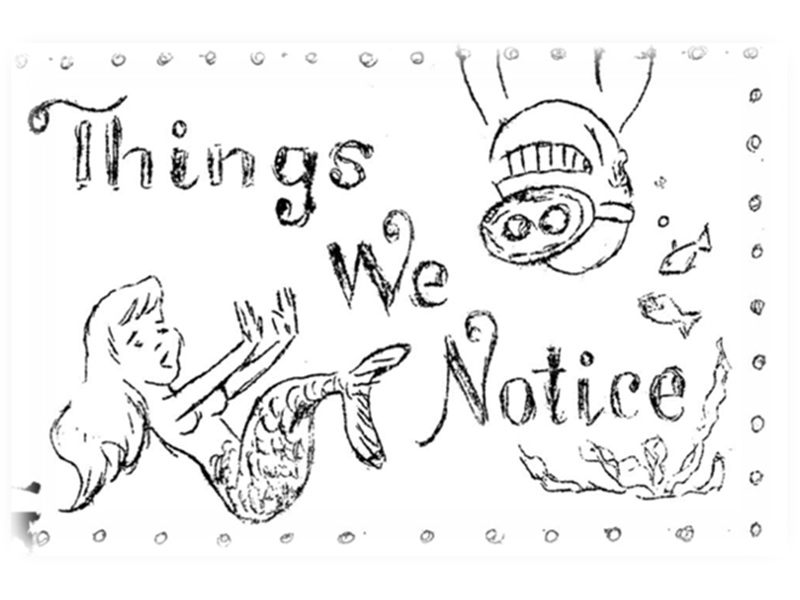
Signal Vol 2, No. 63, 6 December 1961
By April 1962, Julie had started penning short articles about marine life around the Island. Her first was about the banded coral shrimp, accompanied by one of her lively, accurate drawings.
Signal Vol 2, No. 71, April 1962
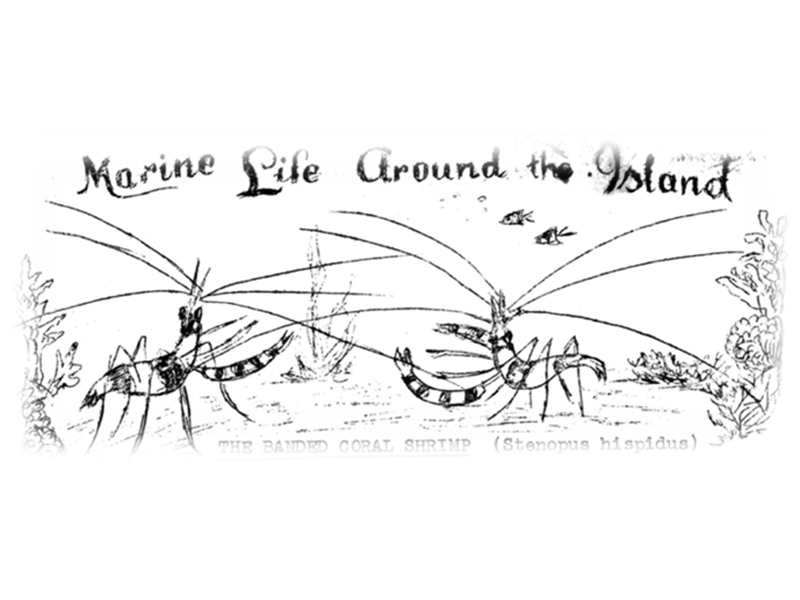
Her articles on sea creatures were inspired by close studies, often over a prolonged period, in which Julie observed the stages of development as well as changes in colour and behaviour. Writing about Doubleheaders (4), Julie used their scientific names and described her efforts to tame them at Ned’s Beach by hand feeding them sea urchins.
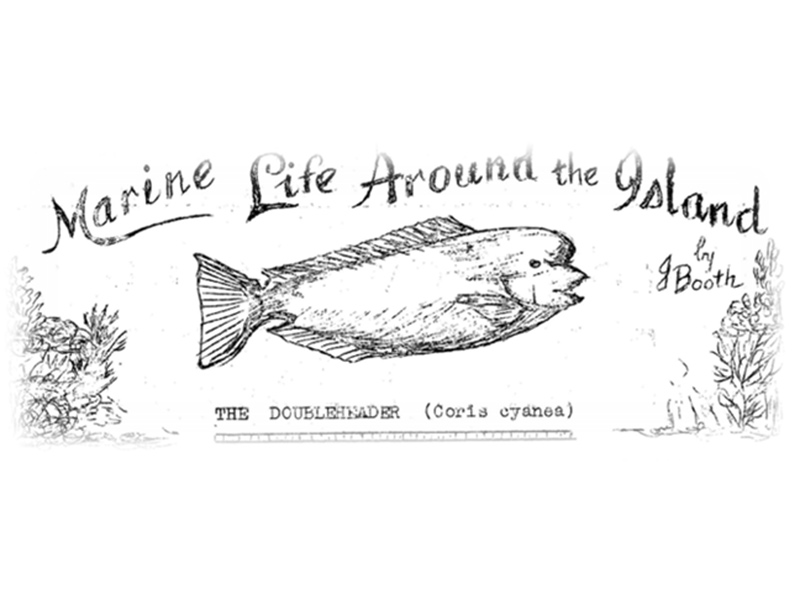
Signal Vol 2, No. 72, April 1962
Her writing about Island marine life displayed a depth of understanding and a desire to share its wonder and beauty with her readers. In her article about the sea snail called a Spanish Dancer (5), Julie invited readers to:
“Don a mask and flippers and glide over the surface of the lagoon. In your imagination, conjure a picture of crystal clear water on a peaceful sunny day…(then watch as this)…shapeless clump suddenly unfurls its mantle, displaying vivid splashes of colour, whirling and contorting whilst the filtered sunlight flashes through the water reflecting the iridescence of a creature so beautiful…”
In August 1962, the Signal quoted an article about Julie that had appeared in the Sydney Morning Herald. It described a painting she had submitted for the “…first Annual Housewives’ Art Competition” at the Hordern Brothers Gallery(6). The Signal also reported on Julie’s growing status as a citizen scientist, noting the Australian Museum had recently awarded her Honorary Researcher status. In recognition of the many interesting fishes she supplied to the Museum from Lord Howe Island and other locations, the Museum even named a species after her – Booth’s pipefish (Halicampus boothae).
Image source: Fishes of Australia (https://fishesofaustralia.net.au/home/species/3189)
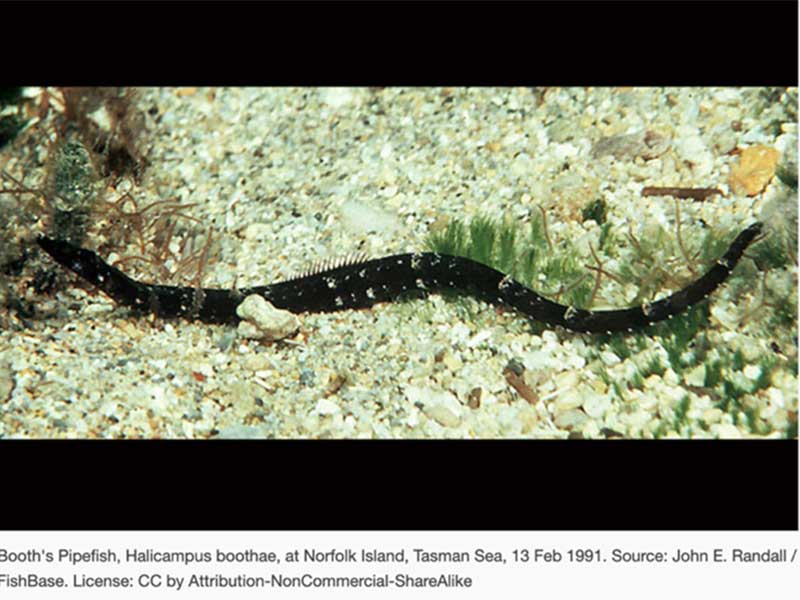
Islander Rodney Thompson can still recall Julie’s time on Lord Howe. “On one occasion they were repairing a flying boat on the mooring at Lord Howe and the engineer dropped one of his tools in the water. They called on Julie and ferried her out to the flying boat to dive for the missing tool,” said Rodney.
Local Larry Wilson also remembers Julie’s commitment to marine research, including many night snorkelling trips in the lagoon to study fish. Soon after her arrival on the Island, a 1961 ABC documentary called “Underwater Artist” captured one of Julie’s signature skills. Unable to afford an underwater camera when she first arrived at Lord Howe, Julie used an unusual method of recording the local sea life. She began painting underwater. Using oil pastels, she painted onto specially treated wallboard. The Lord Howe Island Museum has recently acquired this silent, black and white short film.
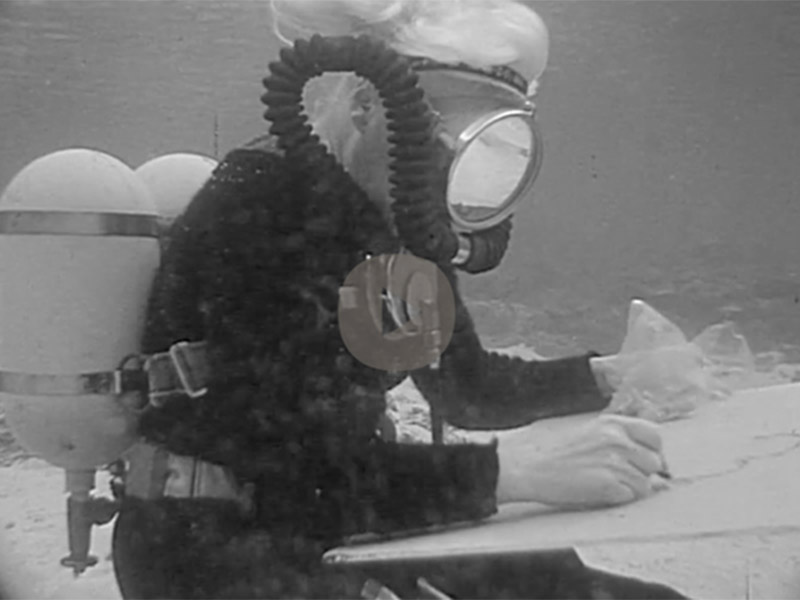
Still from the ABC documentary
“Underwater Artist”, 1961
In the film, we see Julie in full-face mask with twin scuba tanks, selecting a coral outcrop as a subject. Then back on land at her “holiday cottage” (the then newly constructed staff lodgings at Pinetrees) to complete her painting. Now in a short-legged wet suit and black tights, Julie whips out a paint brush from the knife sheath strapped to her right calf to put the finishing touches on her work.
Still from the ABC documentary
“Underwater Artist”, 1961
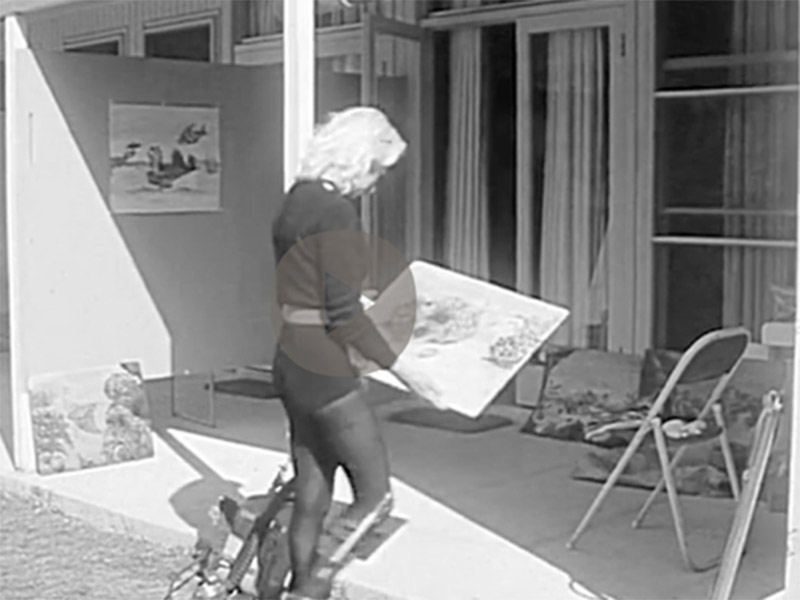
Julie’s art made a return to the Island in 1972 with a visit from MV Coralita, the first live-aboard dive boat in Australia. The Signal(7) reported that Coralita’s twenty “aqualunging” guests included Val and Ron Taylor and other underwater photographers.
Each guest had paid the princely sum of $350 for a 14-day dive trip from Port Macquarie to Brisbane via Lord Howe, Elizabeth and Middleton Reefs. The vessel was “luxurious” with the main saloon “…beautifully fitted out and is highlighted by paintings of island scenes, fish etc. These paintings were done by Julie Booth who is well known to most Lord Howe residents.”
Next time you’re visiting the Lord Howe Island Museum, drop in and ask to view “Underwater Artist”. It’s a remarkable record of Julie Booth, documenting this talented artist and pioneering citizen scientist at work.
Endnotes:
- Canberra Times, Fri 14 June 1968, p. 1 “Lonely Blonde Almost Starved”
- Australian Women’s Weekly, Wed 6 February 1974, p. 8 “A Mermaid Changed for Dinner”
- Signal, Vol. 2 No. 87, Dec 1962
- Signal, Vol. 2, No. 72, Apr 1962
- Signal, Vol. 2, No. 74, 30 May 1962
- Signal, Vol. 2 No. 79, Aug 1962
- Signal, Vol 2. No. 284, Mar 1972.


